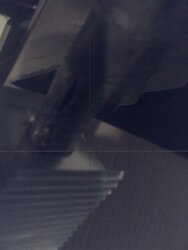Almost got caught -- Might be of interest to those concerned about their water storage freezing while they take a vacation and no heat from the gassifier. I thought I was covered on this one, but instead approached the limit of good luck.
Facts: Tarm Solo Plus 40, about 50 gallons of 50/50 antifreeze mix (no freezing problem here), which feeds the system through a plate hx, installed in shop. 800 gallons of water storage in steel tank inside shop, insulated on top, one side and back (tank acts as radiator to heat the shop). Shop very poorly insulated (old barn), 20 x 40 x 10. Gone for 9 days on vacation.
Backup plan: 5000W electric heat on thermostat to kick-in when shop temp dropped to 40.
Backup outcome: electric heat thermostat failed, and no heat was provided during entire period.
Day 1, 4:00 pm (left for vacation): Fired Tarm this day to heat storage tank to 165 on top, est’d 155 on bottom; Tarm shutdown. Hi/Lo temp today: +8/-12 (F)
Day 2 +8/-16
Day 3 +1/-23
Day 4 +2/-24
Day 5 +6/-12
Day 6 -8/-17
Day 7 -16/-21
Day 8 +14/-21
Day 9 +24/-14
Day 10 +25/+9 9:30 pm, returned from vacation – tank had several inches of ice on top, at least some slush interior, but some liquid water remained; lines from storage to hx frozen, water filter frozen and gasket blown, circ pump frozen, shop temp 10F, turned on small electric space heater directed at tank
Day 11 +36/+6 added more electric heat, removed filter with blown gasket, by 2:00 pm a trickle flow of water through storage system, which in about an hour opened to full flow, ice still in tank. Fired boiler, water in temp from storage to hx 32F, water out temp to storage from hx 90F, boiler in temp to hx 150F, boiler return temp from hx 110F. These temps static until tank storage temp started to rise. Boiler ran continuously thru rest of afternoon and evening.
Day 12 (Monday, Jan 28) +37/+26 Refired boiler after night shutdown, storage tank back up to full heat. All OK.
Since Day 12: made new gasket for water filter and re-installed; replaced thermostat on electric heat; counted lucky stars that steel storage tank did not burst and hx circ pump did not crack
Lest you think N MN remains in the 20's-30's in Jan: Tu +24/-19, We -6/-22, Th (today) -16 low, high forecast +4





 Nothing broken so far though. Leaving my car running so the belts don't shatter on me when I go to start it. BRRRR!
Nothing broken so far though. Leaving my car running so the belts don't shatter on me when I go to start it. BRRRR!